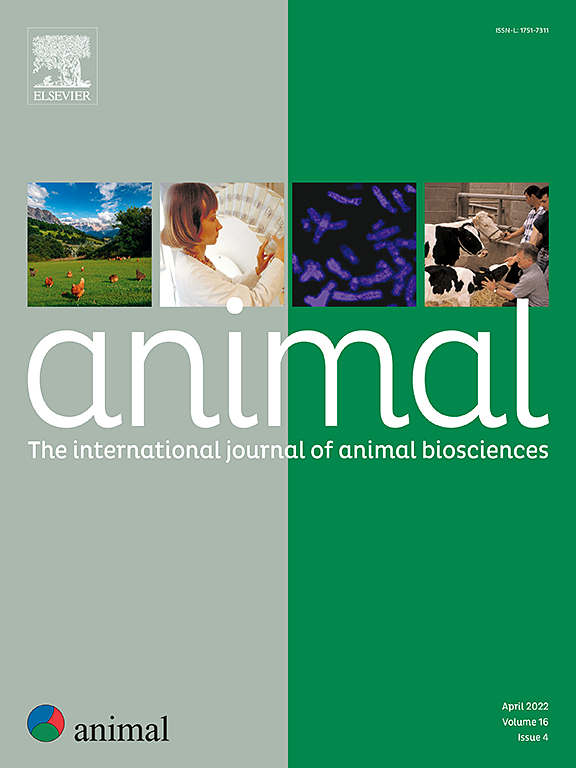个体和猪圈的尾巴状况都会影响育肥期猪的咬尾受害情况
IF 4
2区 农林科学
Q1 AGRICULTURE, DAIRY & ANIMAL SCIENCE
引用次数: 0
摘要
咬尾是商品生猪生产中的一个重大福利问题。本研究对5个猪场(180-441头猪,每个猪场16-30个猪圈)的1 579头未入栏猪(n = 1 579头)在进入育肥场(W0)和9周后(W9)进行个体尾部健康评估,以提供纵向描述性数据,确定咬尾的危险因素,并研究基于W9尾部外观推断W0尾部健康信息的可能性。根据姿态(悬垂)、缩短(远端扁平缺失)、病变类型(TLT;0 =无病变,1 =完整皮肤轻度病变;或有皮肤渗透2 = <;0.5 cm, 3 = 0.5 - 2 cm,或4 = >;2 cm),长度(iL),从W0到W9的变化(ΔL)。ΔL可能包括对收到的咬尾信息的累积,因为变化很大,存在负值。在W0和W9时,完整尾巴的平均长度分别为22±2.1 cm和29±2.3 cm,不受性别的影响。从W0到W9,尾部病变患病率意外下降,可能是由于当前人群中的对接效应,显示W0时相对较高的损伤患病率。以猪(n = 1 323 - 492)为统计单位,猪场内猪圈(n = 94-124)为随机效应,建立预测W9尾健康的混合模型。W0的笔水平尾部出现被纳入合格的预测因子。没有模型预测到TLT 2、3或4在W9,这表明除早期尾巴出现外的其他因素决定了后期受害。与W0时个体的4相比,个体水平因素barrow(相对于女性),iL较大,没有尾巴缩短和任何其他TLT预测较大的ΔL;笔中挂尾的百分比较小,笔中的平均iL (px′L)较大,iL与px′L之间存在相互作用。根据相互作用效应,有两种不同的情景预测了较小的ΔL:较小的iL和px′L,或特别大的iL和px′L。这种情况可能是,习惯了咬尾和两阶段咬尾环境的个体重新瞄准了之前的受害者,在这种环境中,最长的尾巴是最有吸引力的探索对象。我们得出的结论是,在引入育肥场时,尾巴健康状况较好的猪在9周内的咬伤较少。笔级尾健康具有深远的影响,这在尾长度的极端情况下是非常不同的。四分之一的早期皮肤穿透性尾伤可能在屠宰前不久无法检测到。本文章由计算机程序翻译,如有差异,请以英文原文为准。
Tail status at both individual and pen level affects tail biting victimisation in pigs over the finishing period
Tail biting is a significant welfare problem in commercial pig production. Individual tail health was assessed in non-docked pigs (n = 1 579) on five farms (180–441 pigs and 16–30 pens per farm) at introduction to the finishing unit (W0) and 9 weeks later (W9) to present longitudinal descriptive data, establish risk factors for being tail bitten and investigate possibilities to infer information about W0 tail health based on W9 tail appearance. Tail health was described in terms of posture (hanging), shortening (loss of distal flattening), lesion type (TLT; 0 = no lesion, 1 = minor lesion on intact skin; or with skin penetration 2 = < 0.5 cm, 3 = 0.5–2 cm, or 4 = > 2 cm), length (iL) and change therein from W0 to W9 (ΔL). ΔL may include cumulating information on received tail biting given that the variation was large and negative values were present. The average intact tail measured 22 ± 2.1 and 29 ± 2.3 cm at W0 and W9, respectively, with no effect of sex. Tail lesion prevalence decreased unexpectedly from W0 to W9, possibly due to a docking-like effect in the present population showing a relatively high injury prevalence at W0. Mixed models predicting tail health at W9 were built with pig (n = 1 323–1 492) as statistical unit and pen (n = 94–124) nested within farm as random effects. Pen-level tail appearance at W0 was included as eligible predictors. No model predicted TLT 2,3 or 4 at W9, suggesting that factors other than early tail appearance determined late victimisation. A larger ΔL was predicted by the individual-level factors barrow (vs female), a larger iL, no tail shortening and any other TLT as compared to 4 in the individual at W0; as well as smaller percentage of hanging tails in the pen, a larger average iL in the pen (px̅L) and an interaction between iL and px̅L. According to the interaction effect, two different scenarios predicted a smaller ΔL: smaller iL and px̅L, or especially larger iL and px̅L. The scenarios may be re-targeting of previous victims by individuals accustomed to an environment with tail biting and two-stage tail-biting where the longest tails were the most attractive objects for exploration. We conclude that pigs with better tail health at introduction to the finishing unit receive less injurious biting during 9 weeks. Pen-level tail health has a profound effect that is very different at extremes of tail length. One−fourth of early skin-penetrating tail injuries may not be detectable shortly before slaughter.
求助全文
通过发布文献求助,成功后即可免费获取论文全文。
去求助
来源期刊

Animal
农林科学-奶制品与动物科学
CiteScore
7.50
自引率
2.80%
发文量
246
审稿时长
3 months
期刊介绍:
Editorial board
animal attracts the best research in animal biology and animal systems from across the spectrum of the agricultural, biomedical, and environmental sciences. It is the central element in an exciting collaboration between the British Society of Animal Science (BSAS), Institut National de la Recherche Agronomique (INRA) and the European Federation of Animal Science (EAAP) and represents a merging of three scientific journals: Animal Science; Animal Research; Reproduction, Nutrition, Development. animal publishes original cutting-edge research, ''hot'' topics and horizon-scanning reviews on animal-related aspects of the life sciences at the molecular, cellular, organ, whole animal and production system levels. The main subject areas include: breeding and genetics; nutrition; physiology and functional biology of systems; behaviour, health and welfare; farming systems, environmental impact and climate change; product quality, human health and well-being. Animal models and papers dealing with the integration of research between these topics and their impact on the environment and people are particularly welcome.
 求助内容:
求助内容: 应助结果提醒方式:
应助结果提醒方式:


